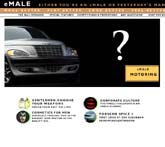|
 
  Top: eMale has
gone for a clean look and gives men what they need for a better lifestyle.
Also, unlike its competitors, it presumes men prefer the real three-dimensional
variety of women, rather than flat images of them on the screen—hence
no girly pics. Above: Hearst finally launched Esquire
as a competitor to GQ and other sites that have their web counterparts
running.
Top: eMale has
gone for a clean look and gives men what they need for a better lifestyle.
Also, unlike its competitors, it presumes men prefer the real three-dimensional
variety of women, rather than flat images of them on the screen—hence
no girly pics. Above: Hearst finally launched Esquire
as a competitor to GQ and other sites that have their web counterparts
running.
Related links
|

|
   
[an error occurred while processing this directive]
‘Boy Power’: a gentlemanly revival
There may be a Men’s Movement in the
media to help guys define who they are in the age of “Girl
Power”, says Jack Yan
IN THE 1990s, it was the New Lad. We'd written much about this
demographic in issues of CAP, how the magazines FHM
and Loaded had grown through their cheeky humour and
how even British GQ had to take the same route.
Earlier this year, we
came across an odd title called The Chap.
Meant to be the antithesis of the New Lad magazine, The Chap
was a tongue-in-cheek look at the modern gentleman, complete
with a cover photo culled from 1950s knitting patterns. We had
a good chuckle but was this for real? Is there a segment of
chaps, who like yours truly, gives a damn about opening the
car door for a lady entering and afterwards, whether one walks
in front or behind the automobile?
A quick trawl of the media shows that there
might be. While there'll always be room for the beer-swilling,
perving male who frequents the lads' magazines, there seems
to be growing emphasis on a more refined sensibility. There
is a Millennium Man, or maybe we should call him the New Man,
just in case he is associated with the Millennium Dome or other
so-passé millennium exercises.
The New Man has had to play catch-up because
the Spice Girls had brought the phrase ‘Girl Power’
into the global psyche, and there was no equivalent ‘Boy
Power’. The word girl no longer had negative connotations
and even spawned gURL in cyberspace. Aggression—the
image of Scary Spice—was OK, as grrl bore witness.
The absence of Boy Power even, according to
commentary I quoted in an editorial I wrote for our sister magazine
Lucire, affected the
test scores of boys. Others pointed to a lack of role models,
and it may be partly true (though readers there may remember
I had a different conclusion explaining teenage male rebellion).
Laddish behaviour is generally not celebrated. Having an overly
healthy libido is bad news for men in position, as President
Clinton found out. Gentlemanly reserve doesn't seem to be natural
at all, yet there seems to be a growing awareness of it right
now.
Despite the attacks of the New Lad, the old
cad—Bond, James Bond—has endured. The mid-Atlantic
Bond, as portrayed by Pierce Brosnan, is somewhat of a caricature
of Englishness, but he seems to be accepted as a gentlemanly
standard by both the lads' magazines and the more grown-up variety.
Our other celluloid heroes have been in the
media lately: AMC, on cable, showed a few Steve McQueen films
earlier this fall. He might not be a Bond, but McQueen remains
cool and quintessentially male. McQueen remained cool, not because
he had a harder shell, but he exercised his mind and chose to
remain cool. Bullitt and The Getaway show a man
fighting for a cause, with his own brand of right and wrong:
is this what we could term ‘Boy Power’ in today's
sometimes apathetic world?
The thinking man is the one shown in many
fashion advertisements: considerate of his attire and his outdoor
activities. The suit of the 2000s is more refined and with it,
more sensible in its origins—witness the celebrated American
designer R. Scott French using the English varsity as inspiration
for his fall 2000 line-up. Even Details had to relaunch
this year as a sort of male W (does that make it M?),
finding out that the laddish route didn't really work.
Whenever we go through an era of affluence,
and in the United States, that is the situation right now, there
is an awareness of dressing better. Colleagues have screamed
Dallas and Dynasty revivals. And in such times,
I expect the New Lad will, just like the Swinger did, fade.
And of course, there is good old-fashioned
marketing. The desire for change—that same desire that
saw customers go from Levi's to Diesel because they don't wish
to look like they were wearing the clothes made by the establishment—sees
the former New Lad mag buyer, realizing that the magazines
were giving pretty much the same thing issue after issue, either
change course or graduate.
Appealing to this segment is one notable web
site. Esquire recently made it online thanks to the chaps
at Hearst, bringing its slightly more grown-up (compared with
Maxim) view of the world. Sure, the girls are there but
Esquire has not made it the primary focus of the site,
following the magazine's formula. Music, films, politics and
a piece on having whisky for brunch feature. Claim to fame this
month has to be President Clinton's exit interview, in complete
form. Readers of the print title won't get that in full.
Men's Journal has been around for a
bit longer with more of a health and adventure emphasis. There
are the usual male musts: gadgets and health, seasoned with
more on travel, sports and sporting goods.
Yet these transplants are not that indicative
of what's really going on. They are a useful insight, but the
independents are closer to the action.
One we came across, and were very impressed
by, was eMale. Out of New Zealand, eMale betrays
its national origin only through its URL. Everything about it
is international in feel. The idea is that one can look sharp
and feel sharp without resorting to the jingle. Men's smellies
are on offer—as are features on men's suits (coming soon),
the best in automobiles, and lifestyle in general. Health is
discussed (erectile dysfunction in the issue we checked out)
but it's part and parcel of men's magazine publishing. Interestingly,
no scantily clad women—but when you see the professionalism
of this site you will realize why they are unnecessary. Even
Steve McQueen has been championed by editor David MacGregor.
Modern Man discusses politics, clothing,
dating, family, travel and gadgets and offers a more general
mixture. There's less glitz and imagery and a greater focus
on the content. Not as sharp in appearance as eMale,
it is regularly updated and seems to point to the man as thinker,
rather than as the grunter or ogler. No girlie pictures here:
it presumes the modern man himself prefers women in the real,
rather than virtual, world.
Bridging the gap between the grown-up guy
and the lad is Sharp Man, which has a modest design with
more on dating tips, grooming, health and toys for boys. It's
in a difficult position because it hasn't gone all lad nor has
it gone all New Man. Publications in the centre take a gamble:
they either stumble on the perfect mixture or they fail because
they appeal to neither limb. But Sharp Man has been around,
which either means huge perseverance (a good sign in itself)
or a healthy readership.
The New Lad grows up into the New Man. Who
is he? A snappy dresser, knowledgeable about trivia on clothing,
cars and drink, up on etiquette and cultivates a distinctive
personal style. But he is not just a celluloid chap. He is prepared
to fight either for justice or for a cause. After losing our
way during Girl Power, we men might be creating a new role model
for the 2000s that could accept the post-Women’s Lib era
more ably than the Swinger, Pig, Playboy or New Lad.
CAP's hot demographic prediction: male
equivalent of Martha Stewart Living. Jack Yan
Jack Yan is editor of CAP
and the chief executive of Jack Yan
& Associates. He holds a master's degree in marketing,
specializing in identity and branding, and their connections to
business performance. He can be reached via the Feedback link
below.

Home |
Contents | Editorial
Your feedback is welcome

|

|
|